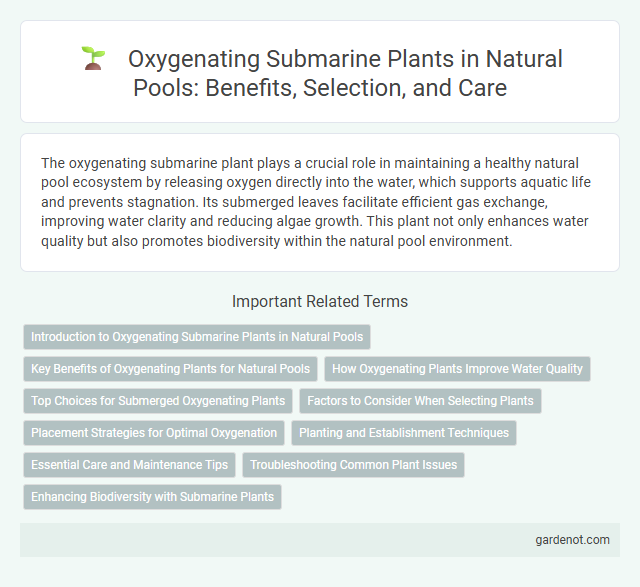The oxygenating submarine plant plays a crucial role in maintaining a healthy natural pool ecosystem by releasing oxygen directly into the water, which supports aquatic life and prevents stagnation. Its submerged leaves facilitate efficient gas exchange, improving water clarity and reducing algae growth. This plant not only enhances water quality but also promotes biodiversity within the natural pool environment.
Introduction to Oxygenating Submarine Plants in Natural Pools
Oxygenating submarine plants in natural pools, such as Elodea and Hornwort, play a crucial role in maintaining water clarity and ecological balance by releasing oxygen directly into the water. These aquatic plants absorb nutrients from the substrate and water, reducing algae growth and supporting beneficial microorganisms. Their presence enhances the self-sustaining filtration process, contributing to a healthier and more vibrant natural swimming environment.
Key Benefits of Oxygenating Plants for Natural Pools
Oxygenating submarine plants improve water quality in natural pools by producing oxygen through photosynthesis, which supports beneficial aquatic life and inhibits algae growth. These plants enhance water clarity, reduce the need for chemical treatments, and maintain a balanced ecosystem by promoting aerobic bacteria that break down organic waste. Their root systems stabilize sediment, preventing cloudiness and fostering a healthy, self-sustaining aquatic environment.
How Oxygenating Plants Improve Water Quality
Oxygenating submarine plants play a crucial role in enhancing water quality by releasing oxygen directly into the water column, which supports aerobic bacteria that break down organic waste and reduce harmful substances. These plants help stabilize aquatic ecosystems by preventing the buildup of toxins such as ammonia and nitrites, leading to clearer and healthier water. Their root systems also trap sediments, reducing turbidity and promoting a balanced natural pool environment.
Top Choices for Submerged Oxygenating Plants
Top choices for submerged oxygenating plants in natural pools include Elodea canadensis, known for rapid oxygen production and water clarity improvement, and Vallisneria spiralis, which offers dense underwater foliage that supports aquatic ecosystems. Myriophyllum spicatum is another excellent option, providing effective nutrient absorption and habitat for beneficial microorganisms. Selecting these plants enhances water quality and balances the natural pool's ecosystem by maintaining optimal oxygen levels.
Factors to Consider When Selecting Plants
Selecting oxygenating submarine plants for a natural pool requires evaluating water temperature tolerance, growth rate, and oxygen production efficiency to ensure optimal aquatic health. Compatibility with existing flora and fauna, alongside resistance to pests and diseases, plays a critical role in maintaining ecosystem balance. Nutrient uptake capacity and submerged growth habit are essential for controlling algae and improving water clarity in natural pool environments.
Placement Strategies for Optimal Oxygenation
Positioning oxygenating submarine plants in areas with steady water flow ensures maximum oxygen diffusion throughout the natural pool, promoting healthier aquatic ecosystems. Strategic placement near pool inlets or shallow zones enhances gas exchange and supports beneficial microbial activity. Concentrating plants in clustered patterns rather than scattered arrangements optimizes oxygen distribution and nutrient uptake for balanced water quality.
Planting and Establishment Techniques
Oxygenating submarine plants play a crucial role in maintaining water clarity and supporting aquatic life in natural pools by producing oxygen through photosynthesis. Effective planting techniques include selecting healthy rhizomes or seedlings and planting them at optimal depths, typically between 15 and 50 cm, to ensure adequate light exposure and nutrient uptake. Establishing these plants requires maintaining stable water conditions and minimizing sediment disturbance to promote root development and rapid growth.
Essential Care and Maintenance Tips
Oxygenating submarine plants play a crucial role in maintaining natural pool ecosystems by releasing oxygen directly into the water, which supports healthy aquatic life and prevents algae growth. Regular trimming of these underwater plants prevents overcrowding, ensuring optimal water circulation and nutrient absorption. Monitoring water parameters such as pH and nutrient levels helps sustain the health of oxygenating plants, promoting a balanced and clean natural pool environment.
Troubleshooting Common Plant Issues
Oxygenating submarine plants in natural pools often face challenges such as algae overgrowth, nutrient deficiencies, and insufficient oxygen production. Identifying symptoms like yellowing leaves, slow growth, or excessive plant decay helps diagnose underlying issues, which may stem from imbalanced water chemistry or poor light conditions. Regular monitoring of pH levels, nutrient availability, and ensuring adequate water circulation improves plant health and maintains optimal oxygenation in the pool ecosystem.
Enhancing Biodiversity with Submarine Plants
Oxygenating submarine plants play a crucial role in enhancing biodiversity within natural pools by increasing dissolved oxygen levels that support diverse aquatic life. These plants create complex habitats that promote the proliferation of microorganisms, invertebrates, and fish species, contributing to a balanced ecosystem. Their root structures stabilize sediments, preventing erosion and improving water clarity, which further benefits the natural pool's overall health.
Oxygenating submarine plant Infographic

 gardenot.com
gardenot.com